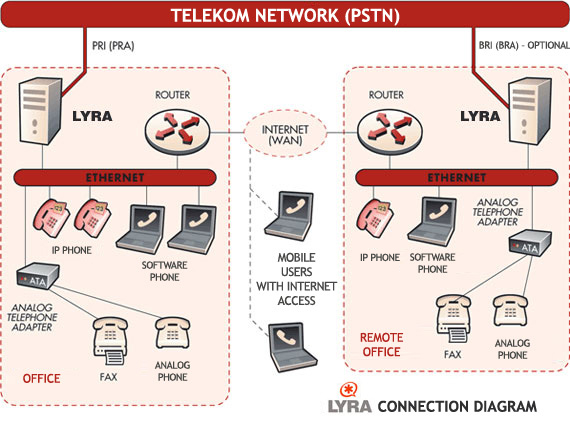Additional or new phone services are usually linked to mobile phone services, while fixed phone lines are often taken for granted. Although the fixed line network is considered 'archaic' and obsolete, it's not necessarily so. The development of new technologies has introduced a plethora of changes and additional features in this area.
Main features of system
System is a flexible and feature-rich choice which offers a complete telephone solution for all types of companies. In addition to the standard PBX functionality, it includes many advanced features. System comprises the the standard telephony (ISDN PRI and BRI – analog lines) and VoIP systems, supporting functions expected of large, standard PBX systems such as voice mail, conference calls, call center, recording and analysis of call detail records (CDR), etc.
Transfer media
- IP-based networks are used as transmission medium for telephone calls
- Widespread distribution and high availability of the IP network allows simple and inexpensive implementation
- Use of existing Ethernet equipment and network
- Possibility of interconnecting telephones/telephone exchanges over the Internet/IP network or via other data transfer systems (Frame Relay, ATM, ADSL, SDSL, ISDN, etc.)
- Network bandwidth depends on the number of simultaneous calls and speech compression algorithms (stronger/weaker compression)
Remote offices and working from home
Connecting remote locations
- Since system allows interconnecting of telephone exchanges located at remote locations through standard data network, it offers a convenient, simple, and price-effective solution for telephone installations at remote locations
- Gives you the ability to create a unified dialing plan
- Offers you the possibility to use resources from a central location at remote locations (ISDN or other line type connected with Telekom)
Working from home or outside the office
- Offers you the possibility of connecting your phone or computer with a software telephone switchboard to the telephony via Internet, from your home or any other location in the world (provided the destination telephone exchange is Internet-enabled)
- Your phone will retain its full functionality and will behave as if it were installed in an office (with features such as dialing via Telekom, call transfer, music on hold, voicemail, etc.)
International VoIP calls
System is connect-ready for VoIP and works with all VoIP providers. To save from international calls, connection is made either via Internet or a data transfer line.
Technologies employed by system for connecting devices and telephone lines
VoIP connections
- Session Initiation Protocol (SIP)
- H.323 (ITU Standard)
- SKINNY (SCCP)
- IAX
- Media Gateway Control Protocol (MGCP)
Standard telephone connections
- Analog protocols
- FXO (Foreign Exchange Office) – for connecting to analog phone lines
- FXS (Foreign Exchange Station) – for interconnecting analog phones
- ISDN Protocols (EuroISDN)
- BRA (Basic Rate Access) – 2 channels per system
- PRA (Primary Rate Access) – channels per system
Supported phones
IP-based phones (supporting SIP or IAX)
- New generation of phones with support for speech transfer via IP networks
- Internal identification number is allocated to every phone by the telephone exhange, thus linking it to a specified phone number
- Different to analog phone lines, characterized by limiting the number of phones depending on the phone line jack, IP-based phones can be moved and used literally anywhere within the local IP network, while the phone number will remain unchanged
- Offer possibility to view the received/sent/missed calls list
- IP-based phones allow easy integration and implementation of new services, such as accessing the shared address book, displaying XML pages, etc.
Analog phones
- System supports interconnecting traditional analog phones with other analog devices in order to use the existing installations, telephones, and fax machines
Supported codecs
Codecs are modules that use complex mathematical algorithms to compress the bit stream that is the digital representation of the analog sound signal. Depending on the compression level, voice calls may require more or less network bandwidth.
The following codecs are supported:
- G.711 a-Law (PCMA)
- G.711 μ-Law (PCMU)
- Linear
- G.723.1
- G.726
- GSM
- ADPCM
- ILBC (Internet Low Bitrate Codec)
- MP3 (only for decoding music on hold)
- G.729 (available as an optional extra, with surcharge)



